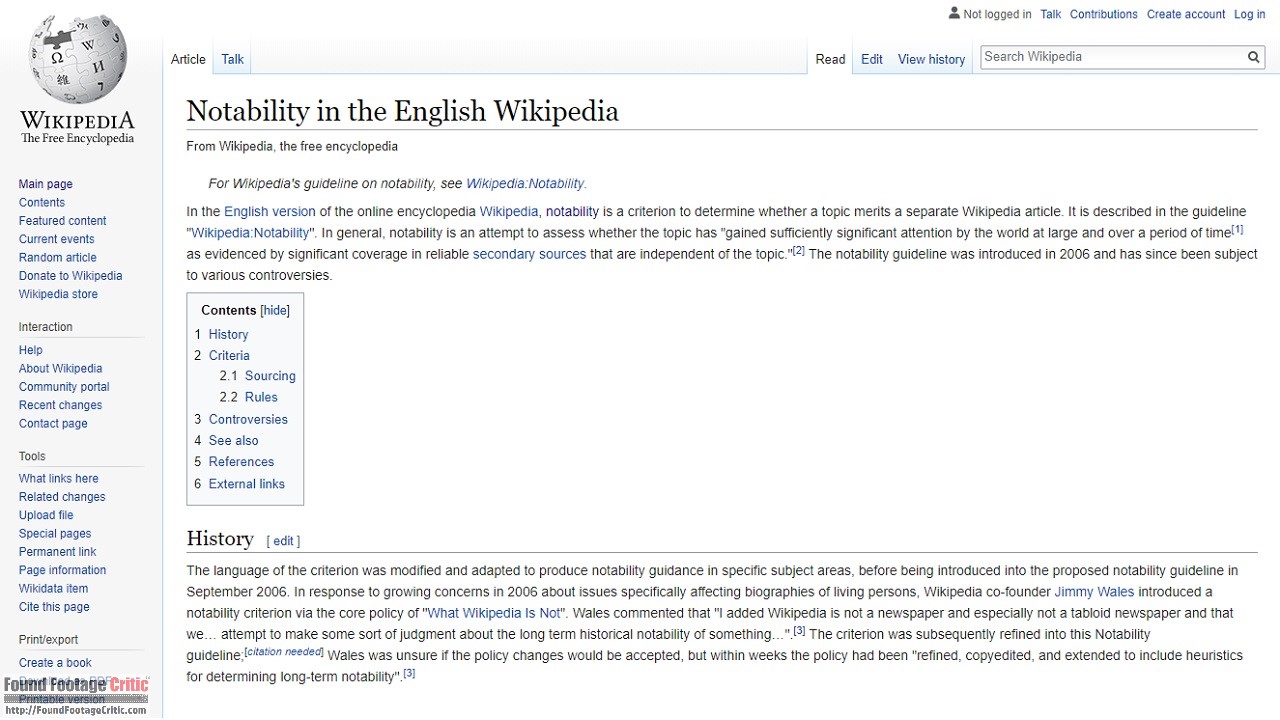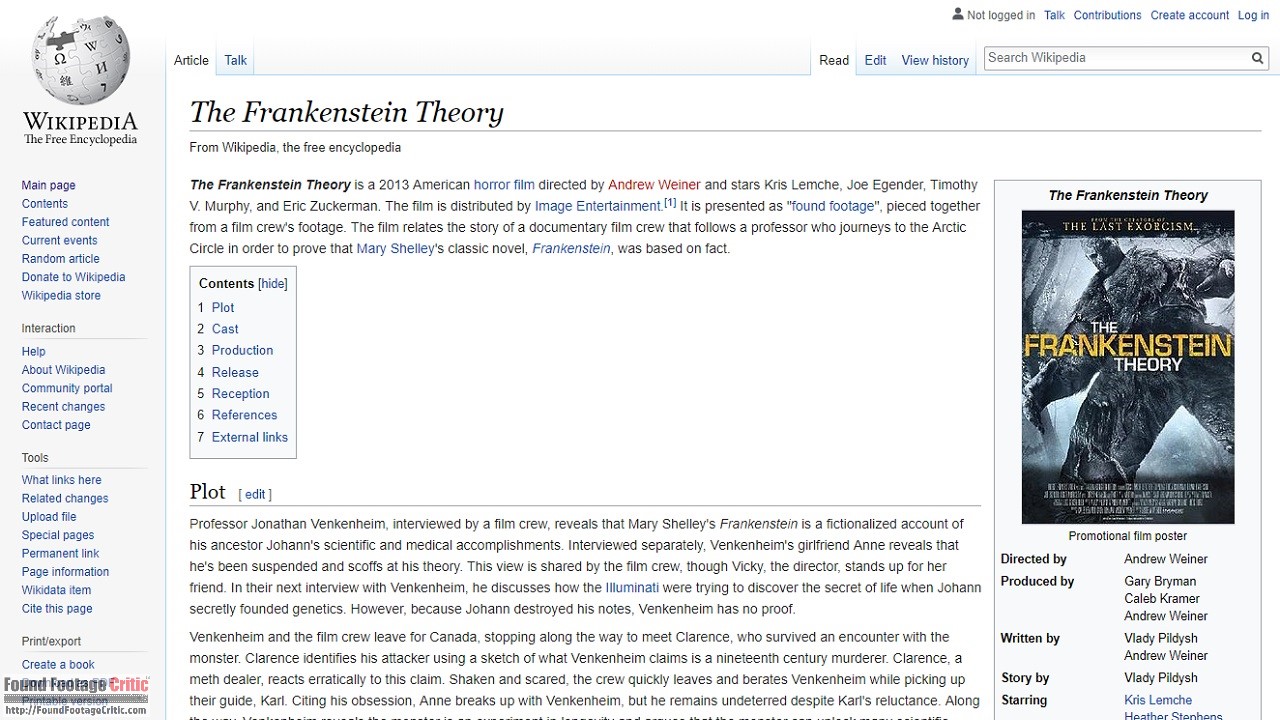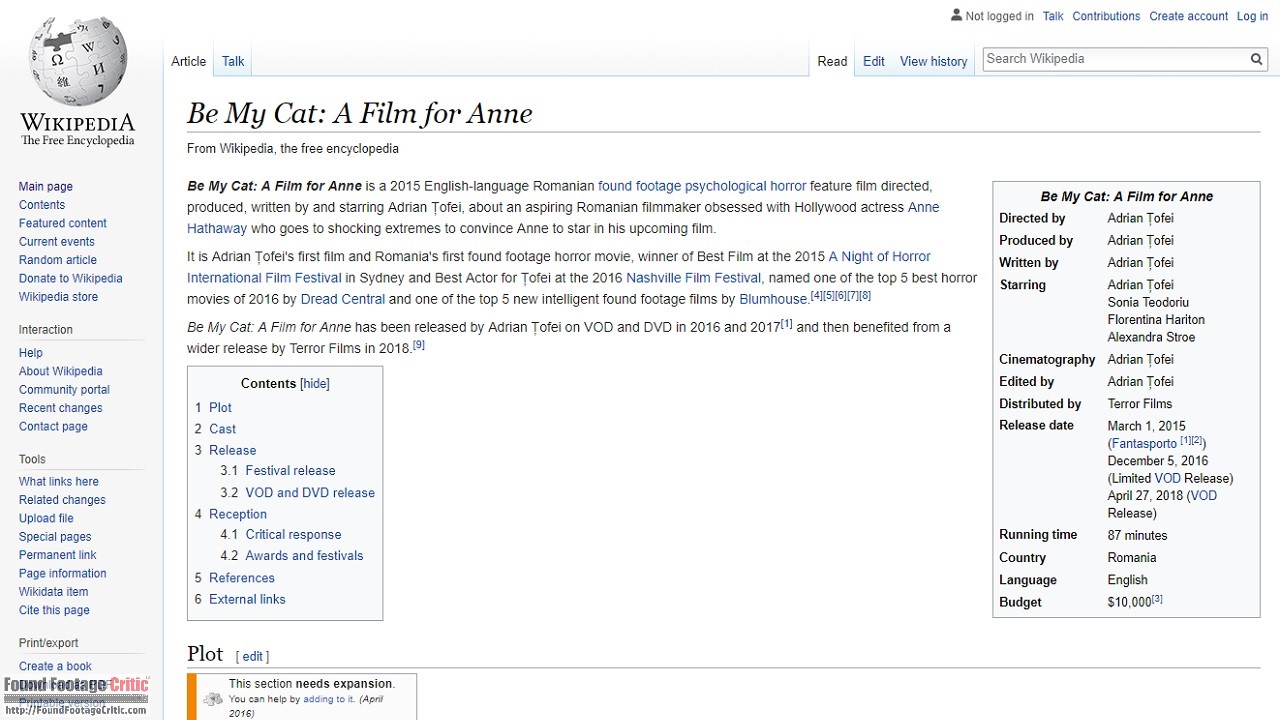Why do some very micro-budget found footage horror films get a Wikipedia page and some don’t? Why do some very micro-budget found footage horror films have a very beautiful Wikipedia page and some are, well, ugly?
And by ugly, I mean a very tiny Wikipedia page with multiple warnings saying things like “this is a stub,” “may be deleted,” “needs additional citations and verifications,” and “this section needs expansion.”
A Wiki for Who?
 Before we go any further, I want you to know I am writing this article for a director who is making her first micro-budget found footage horror movie, never directed a movie, doesn’t work in Hollywood, never went to film school, doesn’t have any known actors in her movie, and has no budget to produce her film, and also has no cash flow to promote her new film.
Before we go any further, I want you to know I am writing this article for a director who is making her first micro-budget found footage horror movie, never directed a movie, doesn’t work in Hollywood, never went to film school, doesn’t have any known actors in her movie, and has no budget to produce her film, and also has no cash flow to promote her new film.
For those readers who did attend film school, and are fortunate enough to procure known talent and meager financing to help out, you can stay—as long as you can refrain from saying, “…but film theory says…”
And I mention these caveats up front because many horror films in this genre are made by first-time directors who have directed their film without any money, and so I am now assuming this person has no cash reserves to help her promote her movie. (I will explain a little later how promoting your film and getting a Wikipedia page for it are almost the same thing.)
Reap the Benefits of Wikipedia
Having a beautiful Wikipedia page for your film is a fantastic accomplishment and one you should strive for. Many micro-budget found footage horror films don’t have a Wikipedia page, or they have a very bare-bones one at best. But some filmmakers get very nice ones. And for a director that has no money, one of the most enjoyable gifts you can give to your actors and film crew who worked so hard for you is for them to see a film they were involved in having its own beautiful Wikipedia page.
And while seeing your film with its own Wikipedia page can be a personal joy of satisfaction, please think of this as a business necessity. At first glance, a Wikipedia page might feel like a vanity piece, but it is not. It is very much a business thing—it is part of your résumé. Someone looking to work with you might say while browsing your film’s Wikipedia page: “I’m impressed. I never heard of it, but I will watch it and see if I’m interested in working with you on your project.” Often before watching a film to check out someone’s work, a person will take a quick glance at the IMDb page for the film, watch the trailer for the movie on YouTube, and read the film’s Wikipedia page.
And most Wikipedia film pages contain what the reviewers have said about the film. “The reviews for this film have been very positive…” “It got mixed reviews…” “Almost all the reviews were negative…” “Variety said the story was…” “Dread Central gave it…” “The film currently holds a rating of 28% on Rotten Tomatoes…” “It holds a rating of 74 on Metacritic (based on 19 reviews…).” You get the idea.
Playing By the Rules: Notability, Citations, and References… Oh My!
I want you to understand something. Wikipedia wants you to have a great Wikipedia page for your new micro-budget found footage horror film. They really do. All Wikipedia is asking of you is that you play by their rules. I will explain what these rules are as we discuss obtaining a Wikipedia page for your film. And always remember this—Wikipedia’s rules are the right rules. And that is because you are playing in their game and so always play by their rules.
To get a Wikipedia page for your film all Wikipedia asks is that your film be notable. Here is where a lot of the confusion comes in. It sounds simple, but often many people don’t understand the meaning of “notable.” What is “notability”? Does it mean successful? Famous? Popular? In the news a lot? Some people treat the word like an occultic mystery, one only the diabolic mind of H. P. Lovecraft could ever have dared to conjure up.
So, what does Wikipedia mean by “notable”?
Actually, they are talking about citation.
“Citation?”
Yes, citation.
“Notability” According to Wikipedia
Whether your film gets a Wikipedia page is almost solely based on whether the things that are said about your film can be proved to be true and are legitimate news stories.
In the Wikipedia universe, notable simply means having enough genuine news articles written about your film so that you can prove that it’s notable. To be very specific, Wikipedia wants you to have at least 15 accepted sources listed at the bottom of your Wikipedia film page to show them your film is worth being on Wikipedia. And most importantly, these sources that are used as references have to be verifiable and credible. Many Wikipedia articles are written with fewer sources, but to have a nice Wikipedia page you want a lot of sources mentioned.
In Wikipedia, you will find on a Wikipedia article a section listed as “References.” It is here where all the sources that were used as references are mentioned.
Basically, I am saying you need to have many articles written about your film to get a Wikipedia page for it. And as I said, these stories and articles must come from places that Wikipedia says are credible (acceptable) and verifiable (provable, think linkable, you can click to the link to go to the site).
“So I have to get a bunch of news stories written about my film? And they have to come from places that Wikipedia says are acceptable? And these articles and news stories will have to be linkable so I can prove that they exist? Is that what you’re telling me?”
Perfect.
Wikipedia… A Marketing Machine?
And hopefully, you are also realizing that trying to get a Wikipedia page for your film and promoting your film are nearly the exact same thing. So even if you were not interested in getting a Wikipedia page for your film (hard to imagine), still you should be promoting your new film by getting as much news stories as you can for it.
I am assuming you have no agent, manager, or public relations firm, or even someone from the distribution company helping you promote your film. And so this means you will be promoting this film only by yourself. And yes, one person can do a great promotion job—fortunately, most of this self-promotion is very cheap. Not all of it, but most of it.
While I am assuming the director is the one who should promote this film, it doesn’t have to be her. Say you are the main actress in a horror film called The Empowerment of the Sataness. It has come out, but only two places have reviewed it, one comparing it to eating out of a vomit bag, the other saying it was so horrible that he had to watch it twice and thinks he’ll watch it again. (It is one of those so bad films you just got to watch it he is saying.)
Well, why don’t you promote it? “Why should I promote it? It’s the director’s or producer’s job to…” Because promoting this movie is promoting your career. And promoting this film will also help you to eventually get a Wikipedia page for yourself too. Be selfish! Promote this film. Remember, each review is going to mention you.
“…I loved it when the main actress tore the head off of the man and then said ‘…We will call this reparations for past historical sexist harassment…’” “When Cynthia Disembowelment (yes, that is her name) begins eating Donald’s belly and then looks at the camera and joyfully smiles, ‘What did you expect? I’m a feminist of the flesh.’” “The scene I enjoyed most was when Cynthia was pouring acid on the muscle man and as he was melting she whispered to him: ‘In this story, the Wicked Witch of the West is the melter and not the meltee.’”
And I should say this to all directors of found footage horror films, if you want a Wikipedia page for yourself, you will find getting a Wikipedia page for your film will definitely help you get a Wikipedia page for yourself. Remember, the stories about your film are stories about you.
Sources, Sources, and More Sources
Let’s get back to talking about sources again.
“But how do I know if a source that I want to use is acceptable? And where do I find are these sources?”
The best way to know if a website or newspaper or magazine is acceptable to use as a reference is to see if it is used as a reference in other Wikipedia articles.
One of the best ways to find these sources is to look at other Wikipedia articles written about found footage horror films. Simply go to a Wikipedia page for a horror movie or a found footage horror film. Have you seen The Frankenstein Theory (2013)? It has a Wikipedia page. Simply go and look at the “Reference” section. You will find Shock Till You Drop, “Review: The Frankenstein Theory;” Washington Post, “The Frankenstein Theory Movie Review;” and Dread Central, “Frankenstein Theory, The 2013,” did reviews of this film. You will also find the Oklahoma Gazette, Ain’t It Cool, DVD Talk, and Fangoria wrote something about this film.
 The vast majority of news stories about your film will be reviews of your film. But interviews, stories about the making of this film, news stories about something related to this film, like distribution deals or winning some kind of film award (usually from a film festival of some sort) are common too.
The vast majority of news stories about your film will be reviews of your film. But interviews, stories about the making of this film, news stories about something related to this film, like distribution deals or winning some kind of film award (usually from a film festival of some sort) are common too.
And assume you will probably not get a Wikipedia page for your film until after it comes out. But there are exceptions. And if Jason Blum wants to involve himself with your film you will get a Wikipedia page very quickly for your film. (But if Jason Blum calls you I dare you to say: “I am not interested in selling my soul! This is a piece of art you will not defile! American philistine, attempt to deprave no more!”)
A Wikipedia Page Done Right
 One of the most impressive micro-budget found footage Wikipedia film pages is Be My Cat: A Film For Anne (2015). That Wikipedia article uses 50 sources! It also mentions all the film festivals it entered, and it entered a lot of them. And it also mentions all the awards it has won from different film festivals. Entering film festivals and winning film awards definitely helps in getting stories written about your film.
One of the most impressive micro-budget found footage Wikipedia film pages is Be My Cat: A Film For Anne (2015). That Wikipedia article uses 50 sources! It also mentions all the film festivals it entered, and it entered a lot of them. And it also mentions all the awards it has won from different film festivals. Entering film festivals and winning film awards definitely helps in getting stories written about your film.
Getting a Wikipedia page for your film is very much dependent on getting publicity for your film.
Think promotion.
Think publicity.
Think stories written about your film.
Wikipedia-Potential? The Horror (2017)
 Let’s pretend I have two friends I haven’t seen in a few years. Both of them were doing their first micro-budget found footage horror films. And let’s pretend both of them contacted me this week. Both of them remember I use to write Wikipedia articles and so both of them ask me to write a Wikipedia page for their films. I’m busy, but I promise to look into both their projects.
Let’s pretend I have two friends I haven’t seen in a few years. Both of them were doing their first micro-budget found footage horror films. And let’s pretend both of them contacted me this week. Both of them remember I use to write Wikipedia articles and so both of them ask me to write a Wikipedia page for their films. I’m busy, but I promise to look into both their projects.
The first film I investigate is called The Horror (2017) and it came out on October 18, 2017. It has two directors, Wayne Harry Johnson, Jr. and Ellery Scott. Wayne is an old friend that was always nice to me. So I try to see what I can do with getting him a Wikipedia page for his film.
I find the film mentioned on IMDb and Found Footage Critic. It stars Katherine Witschen and Danny August Mason. I also find a photo of the movie poster on Pinterest. The trailer is on YouTube, and I feel it needs work—it just doesn’t appeal to me. It just doesn’t look promising. I understand it, but it still seems bland. I find the movie poster very bad, like a high school project. On IMDb the movie is described as a girl making a documentary to help find her friend’s killer, not realizing she is actually the subject of the killer’s own film as she is doing her film. Could be good. Has an interesting twist. On Amazon, I find the film and I rent and watch the film.
I will be honest, I am expecting something unprofessional and bad. The movie trailer and the poster have me leaning to not-going-to-be-good feeling. It turns out it is a decent found footage horror movie, at least structurally. The first six or seven minutes gave me hope, especially the first scene that lets me know what this film is about. We see we are watching a documentary called, “Requiem for Rosalyn,” done by Marion Fish. Marion lets us know her best friend Rosalyn and a male friend of Rosalyn’s were both murdered in a horrifying way and the case remains unsolved. The murderer is still out there, and she wants to help solve this case, or at least let the world know about Rosalyn’s story.
The directing of this movie looks good, although it has some wretched acting in it at times. I always blame the director or directors for bad acting; he is the one who should tell them how to act if they are doing it wrong. I want to mention a lot of little criticisms I have with this movie, but little criticisms are not why you like or dislike a movie. It is the story and how it came out that make you like or dislike a movie.
And the story that came out just doesn’t work for me. It has too many forgettable scenes. There are some very interesting scenes but not enough of them. And the scenes of horror rarely work. They are too dry…something doesn’t amount to horror. Horrifying is hard to do. So the film to me lacks being interesting and horrifying. I loved the concept, but it didn’t come out right. I think it was the story that didn’t work for me. When it’s the story it can’t be fixed by better acting and better directing.
Oh, the Horror!
As for The Horror (2017), there were tiny slivers of hope. A couple of facial close-ups tells me this film could have been done right, or better. There were a couple of scenes, not many, but a couple, that were weird enough for me to see some hope in this film. And I could be wrong. Others might feel and see something I didn’t see or feel. I thought Be My Cat: A Film For Anne (2015) was horrible, just horrible. And yet, I had a woman friend watch Be My Cat: A Film For Anne (2015) and she said “…it scared me to death,” and she wasn’t kidding. She found it very creepy and scary.
Fortunately for me, my opinion of this film has nothing to do with my writing a Wikipedia page for it.
So I begin doing my research to see if there are enough articles written about this film for me to do a Wikipedia page for it. And soon I discover a sad fact. I cannot find any articles written about this film. I can find no reviews of it. And I triple check. It has only an official Facebook page, a Pinterest photo, a trailer, an IMDb page, and it has a page on Found Footage Critic. But I can’t find any reviews. And if any stories are out there about this film they are way too difficult to find for the average person.
I am genuinely sad for my friend, so I do it kindly when I tell him the truth. “You simply do not have enough news articles written about your movie. I can’t write you a Wikipedia page.” “…But what if we try…” I tell him no again. I also explain to him I try to do good Wikipedia pages, not bad ones. And there just isn’t enough news articles to do a decent one.
The Horror… A New Hope?
 Yet, I do tell him some good news for the creator of The Horror (2017) . Well, I hope it is. You have not been panned by a bunch of bad reviews. Actually, it has not made the rounds and been rejected. It is still a relatively new movie. If you like the movie and believe in it, this is what I would do. Make a new trailer for it, a good one. You have more than enough stuff in your film to make a good trailer. The trailer it has now looks like it was made long before the film was ever done.
Yet, I do tell him some good news for the creator of The Horror (2017) . Well, I hope it is. You have not been panned by a bunch of bad reviews. Actually, it has not made the rounds and been rejected. It is still a relatively new movie. If you like the movie and believe in it, this is what I would do. Make a new trailer for it, a good one. You have more than enough stuff in your film to make a good trailer. The trailer it has now looks like it was made long before the film was ever done.
And make a new poster. There is a fantastic shot of this incredible-looking sexy blonde that has four eyes (two above her regular eyes) that would make a great poster. Her image is still with me! And change the name of the movie. The Horror is way too crowded of a word on the Internet. Try not to hide the old name, just don’t call it that anymore. And change the tagline. Change it to “When you look into the abyss, the abyss looks into you.” Yeah, Nietzsche fits perfectly here.
And no one has to feel pathos for Wayne Harry Johnson, Jr., for he has kept himself busy. On August 27th of 2018 another movie he directed came out. What do zombies and hockey equal? Ahockalypse (2018) . (Let’s just be glad he didn’t call it Ahockalypse Now.) It has a pretty good trailer. And this film has gotten a lot of reviews.
He also has a nice website for his movie. At his website, you can see 18 places that reviewed or did a story about his movie. Very, very nice. So Wayne isn’t a sad story at all. And he can do nothing with this film if he and Ellery Scott so desire, or they can improve the selling of it and see where it goes. It is up to them. But it might make a nice self-scientific experiment if they choose to see if they can change it and get reviews for it.
e-Demon (2018), A Wikipedia-Worthy Film?
 The second film I will be looking into getting a Wikipedia page for is for my friend Jeremy Wechter. He wants a Wikipedia page for his film called e-Demon (2018). I love the title. It is perfect! The film premiered in a Los Angeles theater (also later it came out in a New York theater) on September 14, 2018, about a month ago. It also came out on VOD (video on demand) the same day.
The second film I will be looking into getting a Wikipedia page for is for my friend Jeremy Wechter. He wants a Wikipedia page for his film called e-Demon (2018). I love the title. It is perfect! The film premiered in a Los Angeles theater (also later it came out in a New York theater) on September 14, 2018, about a month ago. It also came out on VOD (video on demand) the same day.
I find it has a page on Found Footage Critic, IMDb, and I find the trailer on YouTube. I don’t like the first half of the trailer, but I do like the second half. The first half seems silly and the second half seems scary and serious. I love its tagline, “Evil is going viral.” I don’t like the movie poster. It is a big eye against the backdrop of something, a something I can’t make out. I read the description of the movie on IMDb. A group of friends who are video-chatting finds themselves being attacked and manipulated by an escaped demon who is trying to bring the Devil to Earth. This could be good or bad, depending on how it is done. Then I find it on Amazon and rent it and watch it.
Wow! It is great quality. It has a very interesting story. I really liked this film. I’m impressed. I could see myself watching this film on a regular movie theater screen (Official e-Demon website).
Check Your Sources
Now I will begin my research to see if there are enough news stories written about it for me to try to get it a Wikipedia page. As I said, it has an IMDb page and a page on Found Footage Critic. And then I find a lot of reviews about this film. It is a mixed bag of reviews, some loved it while some definitely did not. These are all the places that wrote something about this movie that I can prove (are linkable) and are credible (acceptable) to Wikipedia:
Ginger Nuts of Horror, Critical Hit, Rue Morgue, Horror Cult Films, Horrorpedia, That Moment In, Hidden Remote, UpComingHorrorMovies, We Are Cult, PopHorror.com, Film Threat, Morbidly Beautiful, Blasting News, Deadline Hollywood, JoBlo.com, Cultured Vultures, The Movie Elite, The Blood-Shed, Starburst Magazine, Assignment X, Horror Fix, DecayMag, HorrorBuzz.com, Adam The Movie God, FilmObsession.com, Movie Nation, Bloody Disgusting, The Horrorcist, IMDb, and Found Footage Critic..
And how do I know these sites are acceptable to use as sources on a Wikipedia article? I go to Wikipedia and type in “Hidden Remote.” And at the bottom a drop down blue box appears that says “containing…” and underneath the word containing in the blue box is the words “Hidden Remote.” I click on the blue box and Wikipedia takes me to Wikipedia articles that have words similar in them like “Hidden and Remote,” or “Hide Remote,” but it also takes me to Wikipedia pages that have the words “Hidden Remote” in them.
And then I click to make sure it is used as a citation. If the reference is twice used, sometimes I accept once, I use it as a citation. If I do not find it appearing in any Wikipedia articles I usually don’t use it, unless there is an exception to this rule, such as it is a new magazine that just came out. So all the sites above I was able to find being used as citations. That’s what makes them acceptable. I don’t check all of the sites, and that is because some of them I already know have been acceptable for years, like Deadline Hollywood, Bloody Disgusting, and JoBlo.com.
eDemon (2018) Passes the Wikipedia Test
And what did the critics say about e-Demon (2018)?
Horrorpedia said: “If you enjoyed Unfriended, then you’ll love e-Demon!” Critical Hit said: “Found Footage horror that should’ve stayed lost.” We Are Cult said: “A film then that fails on every single level,” while PopHorror.com said: “a surprisingly well-crafted new age horror film.” Cultured Vultures said: “Fun Concept with Terrible Execution,” while The Blood-Shed said: “‘E-Demon’ 2018 Takes the Internet by Storm.” And Horror Fuel gives it four out of five skulls.
So when someone writes a Wikipedia page for this movie she should say: “The reviews for this film were mixed, some greatly loving it and some greatly hating it.” And the quotes from the good reviews you may see tomorrow on the movie poster or on a future DVD cover. And these quotes about the quality of the film may end up making it into other news stories…like they are right now being used.
What is very important too many people in the business is what Rotten Tomatoes says and what Metacritic says. Right now e-Demon (2018) has no Metacritic score (it got 2 critics to review it, but it at least needs 2 more reviews before it will give it a score), and it has no Rotten Tomatoes score yet (but it does have a 75% on the audience score, but it is the Tomatoemeter score that is paid attention to). Rotten Tomatoes and Metacritic both only allow the top critics’ scores to count, and it is often hard for a low budget found footage horror film to get noticed by them but some do. (Top critics are usually members of writing guilds and film-critic associations, and they usually write for top newspapers and websites and magazines and TV and cable shows.)
So I will tell Jeremy that his film can definitely get a Wikipedia page for his movie. He has more than enough news stories. It is these news stories which will make you getting a Wikipedia page for your film a doable thing.
Anatomy of a Wikipedia Page: Quotes
And in your Wikipedia page for your film, you will want quotes from notable sources said in different places in the news stories about your film: director or directors…music by…budget…running time…country made in…cinematographer…name of production company or companies…name of distribution company, if you have one, (sometimes the production company is the same, but not always)…how much it made at the box office, if it went out to any theaters…release date…knowledge of when it came out…and how it was released ( a VOD release or a limited city release or both at the same time)…cast members…edited by…tagline (Be afraid, be very afraid)…title…written by…language made in…producers…where it was filmed…Sometimes directors prefer not to say certain things about their movies, like budget and how much it made.
And remember a Wikipedia page for your film usually comes in sections. The box is where the movie poster is put up and a lot of the regular information about your film is said, such as director, title, editor, written by, etc.
And the first thing on a Wikipedia page for a film is simply a description of what it is. “e-Demon is a 2018 independent found footage horror film written and directed by Jeremy Wechter.”
Then we see the describing of your film into sections. And not all Wikipedia film pages have these sections, but many have them or have this section but not that section. Plot (a description of how the story unfolds which can be several paragraphs long), Cast list, Production, Release, Reception, and then we see References and the External links, like your IMDb page for the film, Official website, often a Facebook page. The plot or story description usually requires that one has watched the film to be able to write this part.
Anatomy of a Wikipedia Page: Backstory
And the more stories you have about your film, the more that can be said about it. I now know a lot of information about the film e-Demon (2018). I found articles about it being on Kickstarter in September 2012, but then it was called Evil Alive. And its tagline was “Good has had its chance It’s time to spread some evil.”
And Jeremy has probably one of the greatest pitches for his Kickstarter video. It looks like he successfully raised 10,000 dollars for it. In December 2016, the film won Best Director at the New York City Horror Film Festival. Then it was called The Viral Demon, and its tagline was “Evil is spreading.” (I discovered later there was a bunch of articles about his film I missed because it went under the title of The viral Demon.) And in July of 2018, the movie got a U.S. distribution deal from Dark Cut Pictures.
To me this film’s history is interesting and uplifting. It is a great accomplishment! And I believe all the hardships have made this film a better film. I hope he eventually makes or has made a documentary of how this film was made. I think it would be great to see.
Hopefully, you have been noticing what I am trying to get you to do. What you are doing is writing your Wikipedia page for your film in reverse. See what information other Wikipedia pages have and make sure a news story mentions this information. And have different things said if you can about your film in different articles and stories. This usually naturally happens. But try to promote this by giving out a lot of information about your film.
Anatomy of a Wikipedia Page: Images
Now let’s say you get a Wikipedia page for your movie and you like it, but you notice it would look a lot nicer if it had some photos on it. How can you get photos on your Wikipedia page for your movie?
Simple.
Simply go to Wikimedia Commons and create an account (you’ll need to do this) and then you will be allowed to upload photos (only the ones you have ownership of) on Wikimedia Commons. These photos are for anyone to use, either as part of a Wikipedia article, or for anything else. Newspaper and websites and blogs and magazines can use these photos. So only put photos up you do not mind anyone using.
The first photo you should put up is the theatrical movie poster (I believe this is just the basic movie poster you have for your film). Just put it up and then someone or you can put the movie poster on your Wikipedia page for your film.
The movie Strange Nature (2018) has the theatrical movie poster and also the DVD release cover on its Wikipedia film page. And this looks really nice.
And on your Wikimedia Commons put up photos of yourself, the actors in your film (photos you took of them or own), of you directing the movie, of the movie being premiered, and some still photos from scenes in your movie. Some low budget horror films only have a couple of photos up (some have none), but try to get around fifteen or twenty. Remember, you want the press and reviewer and websites to have access to these photos.
And some good advice, before your movie comes out, if you are a director, have a photo of yourself on your IMDb page. I think you’ll have to join it, but it looks really bad if I go to your IMDb page and you have no photo. And do not forget to have the movie poster of your film on the film’s IMDb page.
Anatomy of a Wikipedia Page: News
And when you are doing your movie and especially when it comes out try to get stories for your film. The main actors in your film should be asked to try to get stories related to this film. “If you graduated from USC see if they will (the college paper) do a story about you in this film.” “Does your hometown of Lincoln, Nebraska, have a local newspaper? Pitch them an idea for a story. Local Girl in First Horror Movie.” Brainstorm with them. “This is your third B-horror movie, why not pitch some horror websites for an interview with you.” And think about who might want to do a story about or review this film. “Okay, my horror film deals with technology. Maybe I should be seeking reviews from technology websites.”
Don’t Get Caught in a Lie!
And do one thing about stories for your film that you do when you pitch them and have them written about your film. TELL THE TRUTH. Do not purposely lie! This is more important than anything you can do. “…We have over 150 thousand dollars for our…” If you say this you can embarrass yourself and others might get hurt. “I agreed to do this edit job because you said…” So please do not purposely lie.
Focus on the good and the hopeful and the facts. “We have an entrepreneurial investor backing our film…” Yes, this can be your father. “We can have it done in six months.” It took three years, but you truly believed it could be done in six months is not a purposeful lie. And when they ask you “…in the beginning of your film you have the words written down ‘This is based on a true story.’ But I never heard about the Bigfoot Massacre.” This is where poetic license may be allowed with only laughter as the victim.
And remember to pre-pitch them stuff so they want to review the movie. The trailer is the big pre-pitch. The poster and tagline are important, but the trailer is the most important part for them to want to review this movie. (But do not dismiss the importance of a movie poster or a tagline.) You can have a bad movie without even knowing it (many directors thought they hit it out of the park when nothing but bad reviews and audience dislike came), but no one should have a bad movie trailer. It is easy to get feedback on a trailer. No one is too busy for a trailer. And so far I have never seen a movie so bad it couldn’t have a good trailer. So have a good trailer.
Three Ways to Get a Wikipedia Page for Your Film
And these are the three specific ways you can get a Wikipedia page for your micro-budget found footage horror film.
1. Get a Lot of Stories About Your Film Out There
This is the way the vast majority get a Wikipedia page for their films. Someone who writes Wikipedia articles will then decide to write a Wikipedia page for your film.
2. Pay Someone to Write a Wikipedia Page for Your Film
There are several professional businesses that do this. If you have the money it might be worth it. But I can’t speak bad or good about this. Some do it this way, but how many I am not sure. And I am not sure about the quality, but if it is a legit business they should be good at this. If you decide to hire a business, let them know about all of the articles written about your film that are acceptable and verifiable. And yes, this means the bad reviews too.
3. Go to Wikipedia and Request a Wikipedia Article be Written About Your Film
Simply go to Wikipedia and see if e-Demon (2018) has a Wikipedia article and if it doesn’t just request it be done.
Putting It All Together
And why did I tell you about the three specific ways of getting a Wikipedia page for your film so late in this paper? I did this because I wanted you to understand that they all depend on you getting a lot of stories written about your film. Whether it just gets made by a Wikipedia writer, or is written by a business, or you request for it to be made, all of these ways will have the same foundation. THEY ALL NEED A LOT OF NEWS STORIES WRITTEN ABOUT YOUR FILM.
I should also mention the fact that writing a Wikipedia article is not a one-person job. I can begin and start a Wikipedia article. But it is also going to be written by others. And it will grow and get improved by others. But when it is started it is important it is done like a Wikipedia article. Again, good citation is key.
And say you wake up tomorrow and you discover your film has a Wikipedia page. But it is very short, ugly, and has a lot of warnings about it. That is okay. If you have a lot of articles written about your film people will start correcting it. I can correct a badly written Wikipedia article, but only if I have a lot of news articles to work with. If I don’t I usually can’t. And do not worry, your page will grow and improve and get better quickly.
Well, I hope this information helps you get a Wikipedia page for your film.
Peter Reynosa is a San Francisco citizen who is attempting to do a micro-budget found footage horror film called The Enlightenment of the Damned, even though he has no money, no experience in acting or film, and is painfully shy around other people.





